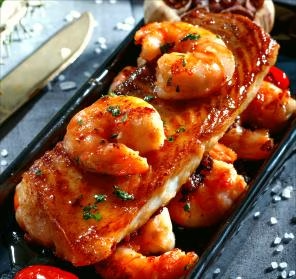Storing shrimp at -35°C maintains a certain level of texture.
The flavor of shrimp depends not only on the initial farming process but also on post-water storage. Freezing white shrimp in their shells with treated seawater reduces moisture loss and maintains a firmer texture after thawing.
However, test results also show that the freshness and texture of shelled white shrimp deteriorate after 30 days, regardless of whether they are frozen in seawater or not. Therefore, it is best to consume them as soon as possible to enjoy the best flavor.
Freezing shrimp with seawater maintains freshness.
Because shrimp are small and their intestines are not immediately cleared after being taken out of water, microorganisms present on and inside their bodies can quickly attack them, causing their flesh to deteriorate more quickly than fish. Therefore, processing plants refrigerate or flash-freeze the shrimp after catching them to reduce bacterial growth and maintain freshness.
However, thawing shrimp meat loses moisture and becomes soft and mushy, so we tried adding filtered seawater to the shrimp for frozen storage, and found positive results.
Seawater Storage Experiment
We selected white shrimp farmed in pure seawater, removed the intestinal mud, and then stored them in their shells for a seawater addition and storage temperature test. The shrimp were stored at -20°C and -35°C for 10 and 30 days, respectively, and their bacterial counts, volatile basic nitrogen, cooking fluid loss, and meat quality were evaluated.
The seawater used to coat the shrimp was filtered through a sand filter and sterilized with UV light, not directly from the aquaculture pond.
Shrimp Freshness is Related to Storage Temperature
The bacterial count and volatile basic nitrogen levels, which affect the freshness of white shrimp, are related to storage temperature. Therefore, regardless of whether or not they were frozen with seawater, white shrimp stored at -20°C had higher bacterial counts and volatile basic nitrogen levels than those stored at -35°C.
Shrimp Coated with Seawater Taste Better
The white shrimp coated with seawater performed significantly better in terms of cooking fluid loss and meat texture. The cooking fluid loss test measures the weight change of the shelled white shrimp after thawing and boiling, revealing the extent of moisture loss.
The meat quality test involved piercing the cooked shrimp using a physical property analyzer to measure the firmness and elasticity of the shrimp.
The results showed that white shrimp coated with seawater and stored at -35°C had the lowest water loss. This is speculated to be because the osmotic pressure of seawater during thawing reduces the loss of interstitial fluid, resulting in a lower cooking fluid loss.
In terms of meat texture, the white shrimp coated with seawater and stored at -35°C showed higher meat firmness after 10 days of storage. After 30 days of storage, there was no significant difference in meat quality between shrimp coated with seawater or stored at -20°C and -35°C, regardless of whether they were coated with seawater or not.
The results of the experiment with white shrimp stored at -35°C and covered in seawater were relatively excellent, and the white shrimp freezing processing industry can use this as a reference for trial use.


Leave a Reply